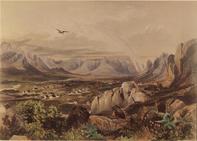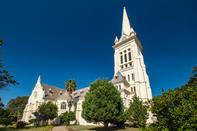Naming of Paarl
Paarl Town, in the Western Cape, lies just over 35 Km northwest of Franschhoek, on the banks of the Berg River, at the foot of a cluster of granite domes. The area was named in 1657, when an explorer from the Cape, Abraham Gabbema, first came across a cluster of granite rock.

With the dew and sunlight glistening on the rock, it reminded him of a large black pearl and so he named the mountains Paarl and Diamandt Mountains, which is Dutch for ‘pearl’ and ‘diamond’. In 1687, Governor Simon van der Stel awarded the first farms in the valley.
In the following year, several French Huguenots settled on the farms of Laborie, Goede Hoop, la Concorde and Picardie. Paarl Town had no formal beginnings but grew haphazardly on either side of what was known as ‘De Kaapsche Wagenpad’ (the Cape wagon road). The original wagon road is now the main road though Paarl, which is lined with oaks.
In 1720, a church was erected, and this is often considered to be the start of the formation of the town. However, settlers had been living there since 1687 and there was a water mill in operation by 1699. Many of the original Paarl farms have now been converted to housing estates, but there are still some picturesque remnants of that bygone era to be seen. The Oude Pastorie (old parsonage) built in 1787 is still standing, and is currently serving as the Paarl Museum.
Wealth of Wagons

In 1840 Paarl became a municipality. Paarl is considered to be one of the oldest towns in South Africa. In 1859, the railway reached Paarl, which helped to form it into a prosperous town, with a farming centre. Paarl also developed some specialised industries, especially the granite works producing granite crafted building stones and tombstones.
Paarl was also known for making wagons and Cape carts. Paarl wagons played an important part in the exploration of Southern Africa. Parts of the Berg River Valley were once known as ‘Val du Charron (valley of wagons) and Wagenmakers Vallei (wagon makers valley) as Paarl’s wagon industry grew.
Lavish houses were built by the wagon makers, reminiscent of the Feather Palace of Oudtshoorn. To appreciate Paarl's wealth of historic buildings, take a walk down Main Road. Starting at the Strooidak Kerk (Thatched Roof Church), dating back to 1805, the walk takes visitors past Zeederberg Square (surrounded by several historic buildings) to the Afrikaans Language Museum.
The only language museum in the world, it focuses on the history of Afrikaans. The walk ends at the Oude Pastorie Museum, built as a parsonage in 1786. The graceful U-shaped manor house, with its pedimented gable, contains a fine collection of antique Cape furniture, silverware and copper.